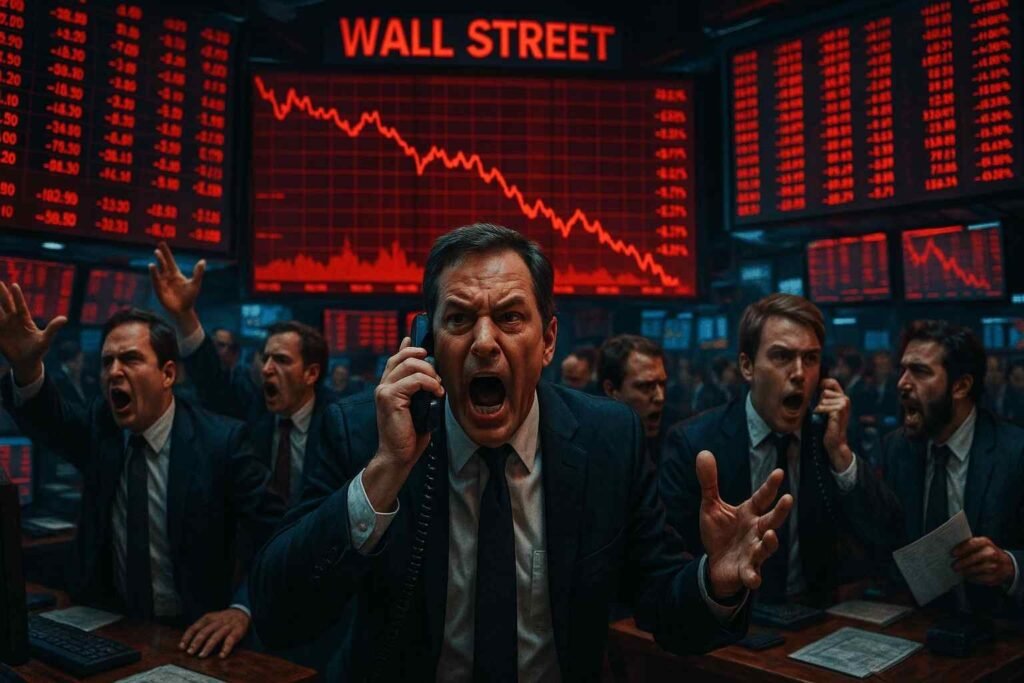
Last Thursday, I got a text from my friend Marcus who works at a hedge fund in Manhattan. “It’s absolute chaos on the trading floor right now. VIX just hit 40. Haven’t seen anything like this since COVID.”
That message captures the essence of what’s happening in financial markets right now. After nearly two years of seemingly unstoppable growth that saw the S&P 500 hit record highs more than 50 times in 2024, Wall Street has entered what traders are calling “volatility hell.”
The Numbers Behind the Panic
For those who don’t obsessively check market indicators (lucky you), here’s what you need to know: the S&P 500 has plummeted into correction territory, dropping more than 18% from its February peak and hovering dangerously close to an official bear market – defined as a 20% decline from recent highs.
The tech-heavy Nasdaq has fared even worse, already in bear market territory with losses exceeding 25% for the year. The “Magnificent Seven” stocks that led the market higher for the past two years have been particularly hard hit, with Tesla down a staggering 33% since the market peak in February.
But the real story is the VIX – the CBOE Volatility Index known colloquially as the “fear gauge.” The VIX has surged above 40 in recent trading sessions, levels not seen since the early pandemic panic of 2020. For context, the long-term median reading is around 17.6. In simple terms, the market is pricing in massive uncertainty and fear.
“When the VIX hits 40, that’s not just normal volatility – that’s institutional investors collectively hitting the panic button,” explained Sandra Mitchell, a portfolio manager I spoke with yesterday. “It means big money is paying premium prices for protection against further market declines.”
Why Now? The Perfect Storm
If you’re wondering what triggered this meltdown, join the club – my retirement account certainly wants to know too. But unlike some market corrections that seem to appear out of nowhere, this one has a clear catalyst: Trump’s sweeping tariffs.
The administration’s implementation of tariffs on virtually every trading partner has created what one Wall Street analyst described to me as “economic policy uncertainty on steroids.” With nearly every sector of the economy now trying to calculate the impact of these tariffs on their supply chains, profit margins, and consumer demand, markets hate what they’re seeing.
I visited my local Target last weekend and chatted with the store manager about price changes. “We’ve had to adjust prices on thousands of products already, and we’re bracing for another round when the additional China tariffs kick in,” he told me. “People are going to feel this in their wallets, no question.”
This economic uncertainty has been amplified by another worrying development: President Trump’s unprecedented public criticism of Federal Reserve Chair Jerome Powell, which has shaken investor confidence in the independence of monetary policy.
I spoke with Dr. James Harrington, an economics professor at UCLA, who didn’t mince words: “Markets can handle bad news, but they can’t handle unpredictable policy. Right now, we have both economic headwinds AND policy unpredictability. That’s why the VIX is through the roof.”
Searching for the Bottom
The million-dollar question (quite literally for many investors) is whether we’ve hit bottom or if there’s more pain ahead. The consensus among traders I’ve spoken with: don’t count on a quick recovery.
“Even today we aren’t at the point where investors can check the box on all the indicators,” noted Brian Jacobsen, chief economist at Annex Wealth Management, in a recent Reuters interview. One concern is that while the VIX has spiked dramatically, it still hasn’t reached the average peak of 37 seen in previous corrections – suggesting we might not have hit peak fear yet.
My friend Alicia, who manages a mid-sized mutual fund, told me over coffee yesterday: “Look, I’ve been through enough market cycles to know panic selling when I see it. This doesn’t feel like capitulation yet – more like the beginning of a reassessment. People are still trying to figure out which sectors might be relatively insulated from tariffs.”
High trading volumes could provide a glimmer of hope. Monday’s session saw the highest trading volume on the SPDR S&P 500 ETF since 2020, which some technical analysts interpret as a potential signal of a short-term bottom. However, history suggests such bottoms often get retested in the weeks that follow.
What Real Investors Should Do Now
If you’re like me, your investment statements have been painful to look at lately. When I checked my 401(k) last week, I quickly closed the browser and decided to take my dog for a walk instead.
But knee-jerk reactions are rarely the right move during market volatility. I called up my former college roommate, now a financial advisor in Chicago, to get her take on what regular investors should do.
“First, don’t panic sell at the bottom – that’s how you lock in losses,” she advised. “But also don’t blindly ‘buy the dip’ in index funds like many did in previous corrections. This time really might be different because of the structural changes happening with tariffs and global trade.”
Instead, she suggested three practical approaches:
- Rebalance across asset classes rather than making all-or-nothing moves
- Consider defensive sectors that might be less impacted by tariffs
- Look at equal-weighted index funds rather than market-cap weighted ones that are dominated by tech giants
For those with cash on the sidelines, patience might be the wisest approach. As another portfolio manager told me, “The market rarely bottoms on a single day. It’s usually a process that takes weeks, if not months. There will be plenty of opportunities to deploy capital at attractive valuations.”
The Human Cost Beyond Wall Street
While financial headlines focus on index points and volatility metrics, the real impact of market turmoil extends far beyond trading floors. Yesterday, I spoke with Elena, who manages a small manufacturing business in Michigan.
“We’ve already had to pause hiring because of uncertainty around input costs,” she told me. “And we’re seriously considering delaying our facility expansion until we understand how these tariffs will affect our supply chain and export markets.”
Multiply Elena’s story across thousands of businesses, and you begin to understand why economists are increasingly concerned about a potential recession. JP Morgan recently raised its probability of a U.S. recession to 60%, citing tariff impacts and market instability.
For everyday Americans, the volatility signals potential trouble ahead for retirement accounts, consumer prices, and job security. The economic uncertainty reflected in the VIX isn’t just an abstract number – it represents real anxiety about the economic future.
Looking for ways to protect your finances during market volatility? Live Chat Jobs connects qualified individuals with flexible remote positions that can provide stable income regardless of market conditions. Having multiple income streams becomes particularly valuable during periods of economic uncertainty.
The Road Ahead: Volatility as the New Normal
If there’s one thing market veterans agree on, it’s that elevated volatility is likely to persist in the near term. The VIX futures curve – which shows expected volatility over time – remains elevated well into the summer months, suggesting traders are preparing for a bumpy ride ahead.
“In the absence of a policy reversal, which seems unlikely based on recent statements from the Trump administration, elevated volatility is likely to remain the base case in the near term,” said Adam Reinert, chief investment officer at Marshall Financial, in comments to Reuters last week.
My take? We’re witnessing a fundamental reassessment of risk in financial markets. The era of easy money and seemingly unstoppable growth is giving way to something more complicated and uncertain. Smart investors will adapt their strategies accordingly.
As I told my anxious brother-in-law when he called about his 401(k) last night: “This isn’t the end of the world, but it might be the end of a market era. The investors who will do best are those who recognize we’re in new territory and adjust their expectations accordingly.”
Find your perfect online opportunity today and build financial resilience during these uncertain market conditions. Whether you’re looking to supplement investment income or create a more stable financial foundation, exploring flexible remote work options can be a smart strategy during market volatility.



